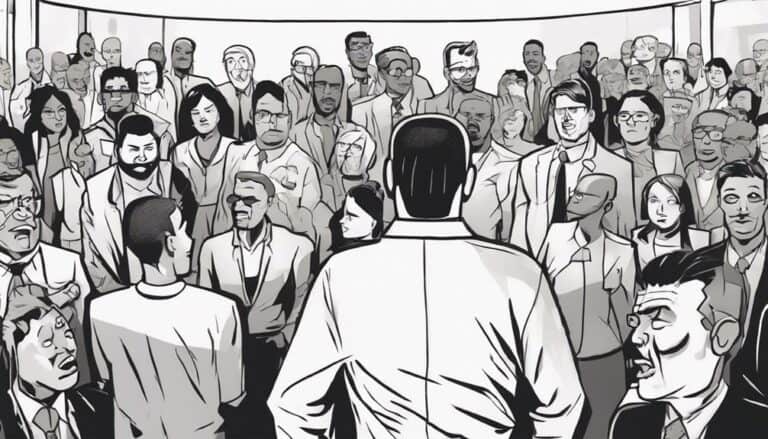Exploring the nuances of leadership communication poses persistent predicaments. From pitfalls like unclear messaging to challenges in aligning with diverse audience needs, the journey of effective communication for leaders is riddled with hurdles.
Yet, by embracing transparency, honing active listening skills, and transcending non-verbal barriers, leaders can pave a path to success.
Let's unravel the intricacies of these common obstacles and explore practical strategies for overcoming them in the domain of leadership communication.
Key Takeaways
- Practice active listening skills to build trust and understanding.
- Tailor messages to align with audience preferences for engagement.
- Monitor non-verbal cues and adjust body language for effective communication.
- Foster inclusivity by considering language and cultural differences in leadership communication.
Lack of Clarity in Messaging
To effectively tackle the issue of lack of clarity in messaging, it's important to establish a foundation of clear, concise communication within your team. As leaders, you face common challenges in ensuring that your team receives and understands messages clearly. Unclear communication can lead to misunderstandings, decreased productivity, and disengagement among team members. One of the key skills required to overcome this challenge is the ability to make your messages clear and easily comprehensible.
To make sure your team grasps the information you convey, it's essential to use simple language and provide sufficient context. Seek feedback to confirm that your messages are understood as intended. By fostering an environment of clear communication, you can address the challenges associated with ambiguous messaging. Your role as a leader is pivotal in setting the tone for effective communication within the team, which directly impacts productivity and cohesion. Invest in honing your communication skills to navigate these obstacles successfully.
Ineffective Active Listening
Enhancing your active listening skills is important for fostering trust, resolving conflicts, and strengthening relationships in leadership communication.
Active listening involves more than just hearing; it requires empathy, interpreting nonverbal cues, and asking clarifying questions to truly understand the speaker's message.
To overcome ineffective active listening, practice mindfulness by staying present in the conversation, maintaining focus on the speaker, and avoiding distractions that hinder comprehension.
Misalignment With Audience Needs
Understanding your audience's preferences and communication styles is essential for effective leadership communication, ensuring alignment and engagement in your message delivery. Misalignment with audience needs can hinder the effectiveness of your communication efforts. To overcome this challenge, consider the following strategies:
- Conduct audience research to gain insights into their preferences and expectations.
- Seek feedback regularly to understand how your messages are being received and make necessary adjustments.
- Adapt your communication strategies by tailoring messages to resonate with the audience's interests and concerns.
Non-Verbal Communication Barriers
Maneuvering non-verbal communication barriers requires keen observation and intentional alignment between your verbal and non-verbal cues. In leadership, body language, facial expressions, and gestures play an essential role in conveying messages. When these non-verbal cues clash with what you are saying, trust and rapport may be compromised. To overcome non-verbal communication barriers, focus on enhancing self-awareness, practicing active listening, and ensuring your verbal and non-verbal cues are in sync. Here is a table summarizing key non-verbal communication barriers and strategies to address them:
| Non-Verbal Communication Barrier | How to Overcome |
|---|---|
| Inconsistent body language | Monitor and adjust posture |
| Lack of eye contact | Maintain appropriate gaze |
| Unintentional facial expressions | Practice expressing emotions |
| Fidgeting or restlessness | Stay composed and grounded |
| Crossed arms | Keep an open and welcoming stance |
Overcoming Language and Cultural Barriers
When maneuvering the challenges of language and cultural barriers in leadership communication, prioritize fostering a culture of inclusivity and understanding to enhance team cohesion and effectiveness.
To overcome these obstacles effectively, consider the following strategies:
- Active Listening: Pay close attention to verbal and non-verbal cues to understand the perspectives of team members from diverse cultural backgrounds.
- Cultural Sensitivity Workshops: Provide language training and workshops that promote cultural awareness to bridge communication gaps and foster mutual understanding.
- Open Dialogue: Encourage open communication where team members feel comfortable expressing their thoughts and concerns, creating an environment conducive to addressing misunderstandings constructively.
Conclusion
As you navigate the challenges of leadership communication, remember that clarity, active listening, audience alignment, non-verbal cues, and cultural understanding are key.
By embracing transparency, empathy, and authenticity, you can overcome these obstacles and foster a culture of open and honest communication.
Keep seeking feedback, honing your skills, and adapting your message to connect effectively with your team.
Embrace the power of communication to lead with impact and drive success.

